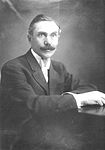
The Progressive Conservative Party of Saskatchewan is a right-of-centre political party in the Canadian province of Saskatchewan. Prior to 1942, it was known as the Conservative Party of Saskatchewan. Members are commonly known as Tories.

The Saskatchewan general election of 1905 was the first provincial election in the newly created Canadian province of Saskatchewan. It was held on 13 December 1905 to elect members of the Legislative Assembly of Saskatchewan. Walter Scott led the Liberal Party of Saskatchewan to victory over the Provincial Rights Party of Frederick W. A. G. Haultain, and became the first Premier of the new province.

The Saskatchewan general election of 1917 was the fourth provincial election in the Canadian province of Saskatchewan. It was held on June 26, 1917, to elect members of the Legislative Assembly of Saskatchewan.

The Saskatchewan general election of 1921 was the fifth provincial election held in the Canadian province of Saskatchewan. It was held on June 9, 1921 to elect members of the Legislative Assembly of Saskatchewan.

The Saskatchewan general election of 1929 was the seventh provincial election held in the Canadian province of Saskatchewan. It was held on June 6, 1929 to elect members of the Legislative Assembly of Saskatchewan.

The Saskatchewan general election of 1934 was the eighth provincial election held in the Canadian province of Saskatchewan. It was held on June 19, 1934, to elect members of the Legislative Assembly of Saskatchewan.

The Saskatchewan general election of 1938 was the ninth provincial election held in the Canadian province of Saskatchewan. It was held on June 8, 1938, to elect members of the Legislative Assembly of Saskatchewan.

The Saskatchewan general election of 1944 was the tenth provincial election in the Canadian province of Saskatchewan. It was held on June 15, 1944 to elect members of the Legislative Assembly of Saskatchewan.

The Saskatchewan general election of 1948 was the eleventh provincial election held in the Canadian province of Saskatchewan. It was held on June 24, 1948, to elect members of the Legislative Assembly of Saskatchewan.

The Saskatchewan general election of 1952 was the twelfth provincial election held in the Canadian province of Saskatchewan. It was held on June 11, 1952, to elect members of the Legislative Assembly of Saskatchewan.

The Saskatchewan general election of 1967 was the sixteenth provincial election held in the Canadian province of Saskatchewan. It was held on October 11, 1967, to elect members of the Legislative Assembly of Saskatchewan.

The Saskatchewan general election of 1975 was the eighteenth provincial election held in the Canadian province of Saskatchewan. It was held on June 11, 1975, to elect members of the Legislative Assembly of Saskatchewan. Blakeney and the NDP were re-elected to a majority government.

The Saskatchewan general election of 1978 was the nineteenth provincial election in the Canadian province of Saskatchewan. It was held on October 18, 1978, to elect members of the Legislative Assembly of Saskatchewan.

The Saskatchewan general election of 1982 was the twentieth provincial election held in the Canadian province of Saskatchewan. It was held on April 26, 1982, to elect members of the Legislative Assembly of Saskatchewan.

The Saskatchewan general election of 1991 was the twenty-second provincial election held in the Canadian province of Saskatchewan. It was held on October 21, 1991, to elect members of the Legislative Assembly of Saskatchewan.

The Saskatchewan general election of 1995 was the twenty-third provincial election held in the Canadian province of Saskatchewan. It was held on June 21, 1995 to elect members of the Legislative Assembly of Saskatchewan.

The Saskatchewan general election of 1999 was the twenty-fourth provincial election held in the Canadian province of Saskatchewan. It was held on September 16, 1999 to elect members of the 24th Legislative Assembly of Saskatchewan.
Richard James "Rick" Swenson is a provincial level politician from Saskatchewan, Canada. He was a member of the Saskatchewan Legislature from 1985 to 1995, and is still active in provincial politics. He was leader of the Progressive Conservative Party of Saskatchewan from 2006 until 2018.
Doyle Vermette is a Canadian politician. He is a member of the Legislative Assembly of Saskatchewan, representing the electoral district of Cumberland as a member of the New Democratic Party. He was first elected in the 2007 general election, and was most recently re-elected in the 2016 general election.

This article is the Electoral history of John Diefenbaker, the thirteenth Prime Minister of Canada.













